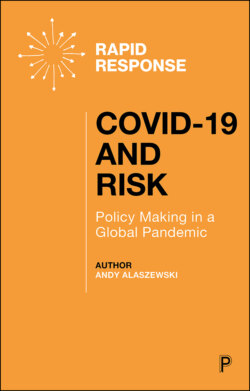Читать книгу COVID-19 and Risk - Alaszewski Andy - Страница 24
На сайте Литреса книга снята с продажи.
Late March: lockdown
ОглавлениеThe shift in policy in mid-March was a recognition that COVID-19 could no longer be framed as a type of flu. While at a distance, COVID-19 had similarities to flu, close up it was clear that COVID-19 was very different. Like COVID-19, seasonal flu is spread by coughs and sneezes and personal contact and tends to affect the upper respiratory tract. Flu usually has a rapid onset and then lasts about three days and is followed by a rapid recovery. If an individual is unlucky, their recovery may be delayed by a secondary respiratory infection. In a minority of cases, this infection is so serious that it requires hospital admission or may result in death. In contrast, SARS-CoV-2, can attack any part of the respiratory system. Most infected people have a relatively mild infection with a dry cough and fever lasting up to ten days. About 14 per cent of those infected have serious infections. In about 5 per cent of cases, the damage is so severe that the infected person needs help with breathing and may need to be placed on a respirator for extended periods (WebMD.com, 2020). In some cases, the body’s immune system may overreact to the infection, creating a lethal cytokine storm. The outcome in serious cases is poor, often death or slow, limited recovery, commonly referred to as long-COVID (KCL, 2020).
Policy makers in the UK did consider using public health measures to control the virus. While there is no evidence that they discussed shutting or monitoring airports and ports, they did discuss tracing and isolating the contacts of infected individuals. The 18 February meeting of SAGE discussed the capacity of Public Health England (PHE). At the time PHE could trace the contacts of five cases a week, which involved identifying and isolating some 800 contacts. This capacity could be increased to 50 cases a week and 8,000 contacts (Cole, 2020). If and when there was evidence of sustained community transmission, the committee felt that this approach would no longer be sustainable. By 12 March, there was clear evidence of community transmission in a rapidly increasing number of cases (Cole, 2020). At this stage, efforts to identify and isolate contacts were abandoned.
By mid-March, it had become clear in the UK that the political cost of pursuing a herd immunity policy was unacceptably high. However, as COVID-19 was spreading rapidly there was too little capacity and it was too late to adopt a public health approach. The only remaining option was the lockdown of all but essential economic, social and health-related activities.
